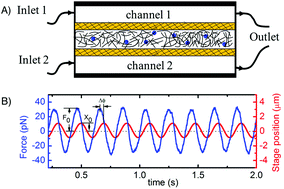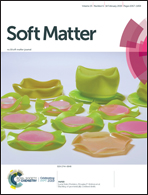Triggered disassembly and reassembly of actin networks induces rigidity phase transitions†
Abstract
Non-equilibrium soft materials, such as networks of actin proteins, have been intensely investigated over the past decade due to their promise for designing smart materials and understanding cell mechanics. However, current methods are unable to measure the time-dependent mechanics of such systems or map mechanics to the corresponding dynamic macromolecular properties. Here, we present an experimental approach that combines time-resolved optical tweezers microrheology with diffusion-controlled microfluidics to measure the time-evolution of microscale mechanical properties of dynamic systems during triggered activity. We use these methods to measure the viscoelastic moduli of entangled and crosslinked actin networks during chemically-triggered depolymerization and repolymerization of actin filaments. During disassembly, we find that the moduli exhibit two distinct exponential decays, with experimental time constants of ∼169 min and ∼47 min. Conversely, during reassembly, measured moduli initially exhibit power-law increase with time, after which steady-state values are achieved. We develop toy mathematical models that couple the time-evolution of filament lengths with rigidity percolation theory to shed light onto the molecular mechanisms underlying the observed mechanical transitions. The models suggest that these two distinct behaviors both arise from phase transitions between a rigidly percolated network and a non-rigid regime. Our approach and collective results can inform the general principles underlying the mechanics of a large class of dynamic, non-equilibrium systems and materials of current interest.

- This article is part of the themed collection: Soft Matter Emerging Investigators


 Please wait while we load your content...
Please wait while we load your content...